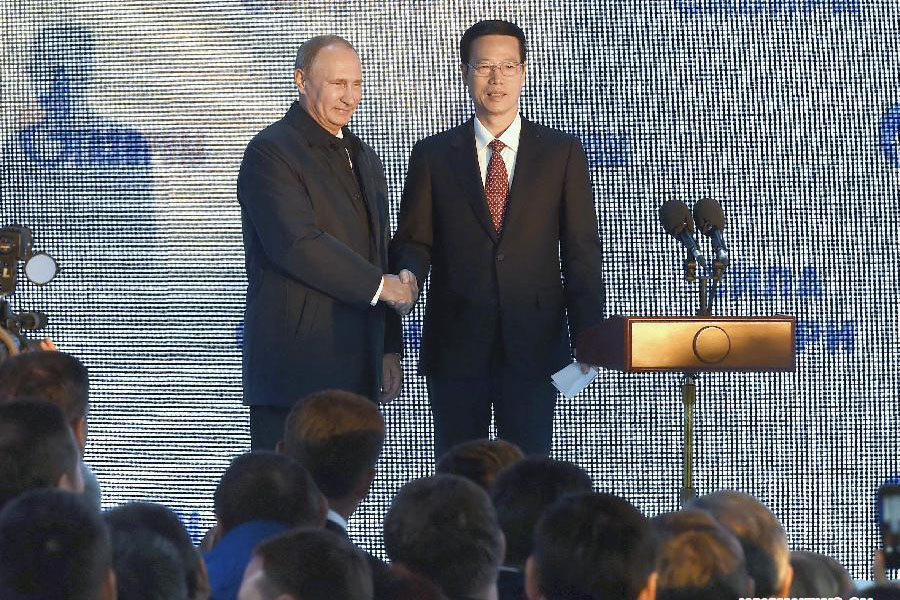
Vice-Premier Zhang Gaoli (R) and Russian President Vladimir Putin attend a start-of-construction ceremony of the Russian part of the China-Russia East Route natural gas pipeline in Yakutsk, capital city of Saha-Yakutia republic, Russia, Sept. 1, 2014.[Xinhua/Liu Jiansheng]
YAKUTSK, Russia — China and Russia on Sept 1 started the construction of a joint natural gas pipeline in Russia’s eastern Siberia, in implementation of a natural gas supply contract signed between the two countries.
Vice-Premier Zhang Gaoli and Russian President Vladimir Putin jointly witnessed the welding of the first roll of pipes on the Russian part of the China-Russia East Route natural gas pipeline in Yakutsk, the capital city of Russia’s Sakha (Yakutia) Republic.
At a start-of-construction ceremony at the Us-Khatyn field in the outskirt of Yakutsk, Zhang and Putin were joined by people from both countries as live video signals from the Chayandin gas field some 1,000 km away was displayed on huge screens.
The Chayandin and Kovyktin gas fields in eastern Siberia will become major sources of supply when the pipeline begins to pump natural gas to China in 2018.
The start of construction of the Russian part of the China-Russia East Route natural gas pipeline signifies a major step forward in implementing the consensus reached between President Xi Jinping and Putin.
During their meeting in Shanghai in May this year, the presidents witnessed the signing of a number of land-breaking contracts between companies of the two countries, including gas supplies and an annual supply of 3 million tons of liquefied natural gas.
The Russian part of the joint-venture pipeline, which starts at the Kovyktin and the Chayandin gas fields, will extend through existing pipelines in eastern Siberia and end in the Far East port city of Vladivostok.
The China-Russia East Route natural gas pipeline will be jointly built by China National Petroleum Corporation (CNPC) and Gazprom of Russia, with the latter responsible for building the part within Russian borders.
The Russian part of the pipeline, officially named “the Power of Siberia” pipeline, has a designed capacity of transmitting 61 billion cubic meters of natural gas every year.
According to a CNPC-Gazprom contract, the Russian side will export 38 billion cubic meters of gas to China through the pipeline every year for a 30-year period starting from 2018.
Fast growing energy cooperation has become a core ingredient of China-Russia comprehensive strategic cooperative partnership and has helped advance it into a new era of development. In addition to the East Route gas pipeline, the two countries are in negotiations on the construction of the West Route gas pipeline.
Under the CNPC-Gazprom agreement, the Russian side will export 70 billion cubic meters of natural gas to China every year upon completion of both the East- and West-Route gas pipelines.
The two sides have also jointly built and put into operation a China-Russia oil pipeline in the Far East. In 2013, China imported 24.35 million tons of crude oil, 27.28 million tons of coal and 3.5 billion kwh of power from Russia.
Russian Deputy Prime Minister Arkady Dvorkovich said earlier this year that Russia has the capacity of tripling or quadrupling the current volume of electricity and coal exports to China.
The CNPC and Russia’s oil giant Rosneft will build a joint-venture oil refinery in Tianjin in north China, which will be able to process 16 million tons of crude oil every year.
In the field of nuclear energy, the China-Russia joint venture Tianwan nuclear power plant in east China already has two reactors put into trial operation, and the other two are under construction.
Xi and Putin have agreed to “establish a comprehensive energy cooperation partnership” during their meeting in May, Gazprom Chairman of the board of directors Alexey Miller said Saturday.
“We are making all-out effort to implement the consensus reached between President Putin and President Xi Jinping,” Miller said.
